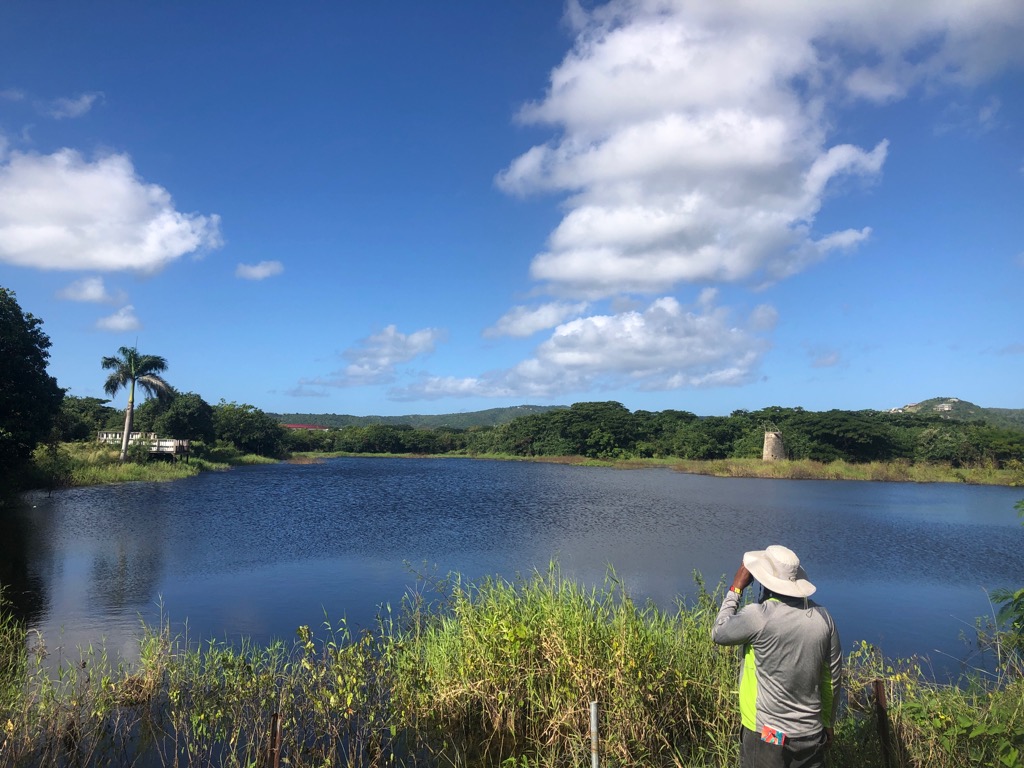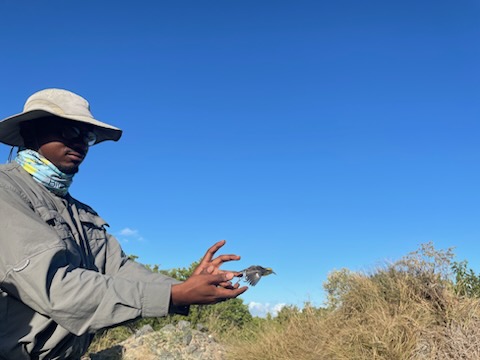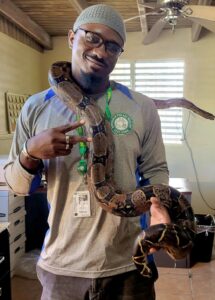(This is the first of a three-part series taking a closer look at some of the research projects undertaken by staff at the V.I. Department of Planning and Natural Resources Division of Fish and Wildlife.)
Lately, Jahnyah Brooks has been spending much of his time counting bugs, and to hear him tell it, he couldn’t be happier.

It’s just part of his work as a wildlife biologist.
“I grew up in the bush a lot,” Brooks said. Born on St. Thomas, he spent most of childhood on St. Croix, imbibing the heady scent of nature, spying on birds and insects, exploring the haunts of feral creatures, and learning their ways from his mother, a wildlife enthusiast who used detailed flashcards to teach him the mysteries of the world around him.
Having completed his education and a four-year stint in the U.S. Army, Brooks is back on St. Croix working with the Fish and Wildlife Division of the V.I. Department of Planning and Natural Resources. He was a summer intern there before and was hired full-time last October.
He’s already a published researcher.
Last year, the Caribbean Journal of Science published a paper Brooks co-authored about bryophytes found in the Virgin Islands. That’s a class of plant that includes mosses and their cousins, liverworts.
“Bryophyte Diversity and Distribution in the Virgin Islands Based on Historical Collections” was one of eight peer-reviewed research works published in 2022 by respected international scientific journals that were written, or co-written, by DPNR staff members.
Unlike much of Brooks’ work, the bryophyte research was not hands-on. Rather, it was conducted primarily via computer, examining years of records, hunting for references and dissecting clues to locate the oft-overlooked plants.
“We found 115 species of bryophytes that belong to 28 families: 83 mosses, 30 liverworts, two hornworts,” according to the study. More than half — 55 percent — of the various types were found on St. Thomas.
The report said that there seemed to be a correlation between an island’s elevation and the total number of species found. In a recent interview with the Source, Brooks expanded that idea, saying there could be other factors at play. For one thing, there has been more plant research conducted on St. Thomas than on the other Virgin Islands, so there was a greater likelihood of discovering bryophytes.
But no one ever zeroed in on mosses and the like before, which Brooks speculated may be one reason his research got such traction.
“It’s so interesting because no one ever did this in the Virgin Islands,” he said, adding, “It’s still a work in progress,” and indicating he is still researching mosses and other bryophytes.
Meanwhile, he is busy with other projects as part of his job with Fish and Wildlife. Those include banding and tracking bird populations and helping to round up red-tail boas, a popular exotic pet that is not native to the islands and first appeared loose on St. Croix in the early 2000s, raising suspicions that a pet owner had released one or more on the island.

The invasive boas have become such a problem that DPNR started a bounty program a year ago, offering $100 per snake over four feet in length and $50 for those under four feet, but only to trained and certified handlers.
Brooks advised members of the general public to call the department at 340-773-1082 if they spot a boa in the wild on St. Croix.

If he’s not charming snakes or tracking birds, Brooks may be busy counting bugs.
For about two years, going back to his intern days, he has been collecting data on arthropods commonly found on St. Croix. Arthropods include spiders, insects and crabs and other animals with an exoskeleton and a jointed body.
It’s part of the project to reintroduce and support the ground lizard on the big island.
Another of the Fish and Wildlife research papers published in 2022, with the division’s director Nicole Angeli as a lead author, was about “Imperiled Caribbean Teiids and Conservation of the Critically Endangered St. Croix Ground Lizard.”
That study concluded that over the past 50 years, the ground lizard population has declined because of a combination of invasive predators (especially rats) and vanishing habitat. In general, the animal has been pushed from the larger islands to the uninhabited islands and cays.
Ground lizards like to eat arthropods, so one thing researchers are checking on is whether St. Croix has enough of them to offer.
It does. “Definitely,” Brooks said.
He’s been routinely checking the arthropod populations at Green Cay, Ruth Cay, Protestant Cay, the wetlands at the University of the Virgin Islands, South Gate, and Sandy Point. He lowers an 8-ounce plastic cup into the ground as a trap and leaves it there for two days. Then he returns and counts the number of arthropods that he’s collected.
One time the cup held 500 crickets. Another time he found 4,500 springtails, which are about the size of a flea. That’s quite a few meals for a ground lizard.
Overall, Brooks concluded, there are enough arthropods on the island to support a substantial population of ground lizards. “They have enough food here on St. Croix,” he said.
The lizard is unlikely to run out of arthropods, so Brooks is unlikely to run out of projects. The islands contain enough animals to last any bio-researcher a very interesting lifetime.





